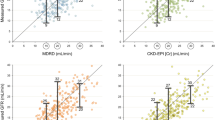Abstract
The Center for Medicaid and Medicare Services (CMS) has recently revised their end-stage renal disease (ESRD) Medical Evidence Report, Medicare Entitlement, and Patient Registration CMS 2728 Form. The modified algorithm calls for the use of formulae to estimate glomerular filtration rate (GFR). The new criterion is defined as estimated GFR of less than 20 ml/min per 1.73 m2. GFR is either estimated by Schwartz formula (CSCH) in children or Modification of Diet in Renal Disease formula (CMDRD) in adults. The purpose of this communication is to test the validity of the new CMS GFR algorithm in detecting children who need renal replacement therapy. We evaluated two cohorts of children. Group I included single-center data from 626 125I-iothalamate clearance studies (CIO) that were compared with the simultaneous estimation of GFR by CSCH. Group II included data on 659 children from the patient incidence registry obtained from the ESRD Network of Texas between February 1996 and October 2003. In group I there were 76 children (76 CIO) with CSCH less than 20 ml/min per 1.73 m2 of whom 50 (67%) had CIO less than 15 ml/min per 1.73 m2. Of children with CIO less than 15 ml/min per 1.73 m2, 62% had a CSCH less than 20 ml/min per 1.73 m2. The ability of CSCH greater than 20 ml/min per 1.73m2 to predict CIO greater than 15 ml/min per 1.73 m2 (negative predictive value) is 0.95. The number of children who were started on dialysis in Texas within the study period was 659 (group II). The mean CSCH±SD was 10.8±7.7 ml/min per 1.73 m2. Of the patients who were initiated on dialysis, 94% had CSCH less than 20 ml/min per 1.73 m2. The results were sustained when race, gender, age range, and type of diagnosis were considered. The new CMS algorithm provides a good negative predictive estimate of GFR less than 15 ml/min per 1.73 m2.

Similar content being viewed by others
References
Shemesh O, Golbertz H, Kriss JP, Myers BD (1985) Limitations of creatinine as a filtration marker in glomerulopathic patients. Kidney Int 28:830–838
Walser M, Drew HH, La France DN (1988) Creatinine measurements often yield false estimates of progression in chronic renal failure. Kidney Int 34:412–418
Carrie BJ, Golbetz HV, Michaels AS, Myers BD (1980) Creatinine. An inadequate filtration marker in glomerular diseases. Am J Med 69:177–182
Hellerstein S, Alon U, Warady BA (1992) Creatinine for estimation of glomerular filtration rate. Pediatr Nephrol 6:507–511
Cockroft DW, Gault MH (1976) Prediction of creatinine clearance from serum creatinine. Nephron 16:31–41
Bjornson TD, Cocchetto DM, McGowan FX, Verghese CP, Sedor F (1983) Normogram for estimating creatinine clearance. Clin Pharmcokinet 8:365–369
Schwartz GJ, Haycock GB, Edelmann CM Jr, Spitzer A (1976) A simple estimate of glomerular filtration rate in children derived from body length and plasma creatinine. Pediatrics 58:259–263
Levey AS, Bosch Jaun P, Lewis JB, Greene T, Rogers N, Roth D (1999) A more accurate method to estimate glomerular filtration rate from serum creatinine: a new prediction equation. Ann Intern Med 130:461–470
Guruprasad M, Sarnak MJ, Levey AS (2001) Prediction equations to estimate glomerular filtration rate: update. Curr Opin Nephrol Hypertens 10:785–792
Seikaly MG, Browne R, Bajaj G, Arant BS (1996) Limitations to body length/plasma creatinine ratio as an estimate of glomerular filtration in children. Pediatr Nephrol 10:709–711
Davies JG, Taylor CM, White RHR, Marshall T (1982) Clinical limitations of the estimation of glomerular filtration rate from height/plasma creatinine ratio: a comparison with simultaneous 51 Cr edetic acid slope clearance. Arch Dis Child 57:507–610
Bajaj G, Alexander S, Browne R, Sacarcan A, Seikaly MG (1996)125I-Iothalamate clearance in children. A simple method to measure glomerular filtration. Pediatr Nephrol 10:25–28
Vogeli R, Riedwyl R (1971) Comparison of glomerular filtration rate and effective renal plasma flow determinations obtained by a single injection technique and means of standard clearance technique in children. Acta Paediatr Scand 60:528–532
Groth T, Tengstrom (1978) The usefulness of 125-I-sodium- iothalamate as a GFR indicator in single intravenous injection tests. Ups J Med Sci 83:53–63
Eknoyan G, Levin NW (2002) K/DOQI guidelines. Am J Kidney Dis 39:S14–S214
Acknowledgements
We are indebted to the efforts of the staff of ESRD Network of Texas Inc (Network 14), especially Leigh Husni and Nancy Carlson, for providing the network data.
Author information
Authors and Affiliations
Corresponding author
Additional information
Disclaimer The analyses upon which this publication is based were performed under contract number 500–03-NW14 entitled End-Stage Renal Disease Networks Organization for the State Texas, sponsored by the Centers for Medicare and Medicaid Services, Department of Health and Human Services. The content of this publication does not necessarily reflect the views or policies of the Department of Health and Human Services, nor does mention of trade names, commercial products, or organizations imply endorsement by the U.S. Government. The authors assume full responsibility for the accuracy and completeness of the ideas presented. This article is a direct result of the Health Care Quality Improvement Program initiated by the Centers for Medicare and Medicaid Services, which has encouraged identification of quality improvement projects derived from analysis of patterns of care, and therefore required no special funding on the part of this contractor. Ideas and contributions to the author concerning experience in engaging with issues presented are welcomed.
Rights and permissions
About this article
Cite this article
Seikaly, M.G., Loleh, S., Rosenblum, A. et al. Validation of the Center for Medicare and Medicaid Services algorithm for eligibility for dialysis. Pediatr Nephrol 19, 893–897 (2004). https://doi.org/10.1007/s00467-004-1488-y
Received:
Revised:
Accepted:
Published:
Issue Date:
DOI: https://doi.org/10.1007/s00467-004-1488-y




